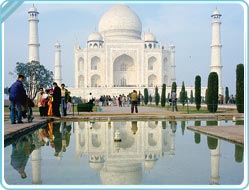 There was a great challenge to ensure uniform and undiminished water
pressure in the fountains which was met by adopting an inventive method.
The fountain pipes were not connected directly with the copper pipes
feeding them as it would have resulted in a steady decrease in the
volume and pressure of the water. As an alternative a copper pot was
provided under each fountain pipe-which was thus connected with the
water supply only through the pot water first fills the pot and then
only rises at the same time in the fountains. The fountains are thus
controlled by the pressure in the pots and not by pressure in the main
pipe. As the pressure in the pots is consistently distributed all the
time, it ensures an equal supply of water at the same rate in all the
fountains. This was really a work of great foresight.
There was a great challenge to ensure uniform and undiminished water
pressure in the fountains which was met by adopting an inventive method.
The fountain pipes were not connected directly with the copper pipes
feeding them as it would have resulted in a steady decrease in the
volume and pressure of the water. As an alternative a copper pot was
provided under each fountain pipe-which was thus connected with the
water supply only through the pot water first fills the pot and then
only rises at the same time in the fountains. The fountains are thus
controlled by the pressure in the pots and not by pressure in the main
pipe. As the pressure in the pots is consistently distributed all the
time, it ensures an equal supply of water at the same rate in all the
fountains. This was really a work of great foresight. As for main supply of water, it was obtained through earthenware pipes. One such main line of supply was discovered under the bed of the western canal. The original intent of the builders of the Taj was probably to present a synthetic composition. The irrigation work at the garden is a great example of this. The garden is irrigated by the overflowing of canals; exception being the outlets at the two extreme ends. The fountains provide inlets to the north-south canal. The west-east canal received its water through an interconnection with the north-south canal. The quarters near the canals received an adequate supply of water while the distant quarters got a smaller supply as the quarters near the canals could be used for growing flower and other plants which would not obstruct the general view. The distant quarters on the other hand ware suitable only for tall trees. The Taj Mahal is perhaps the only monument of the world with such great aesthetic considerations so detailed and yet so influential.